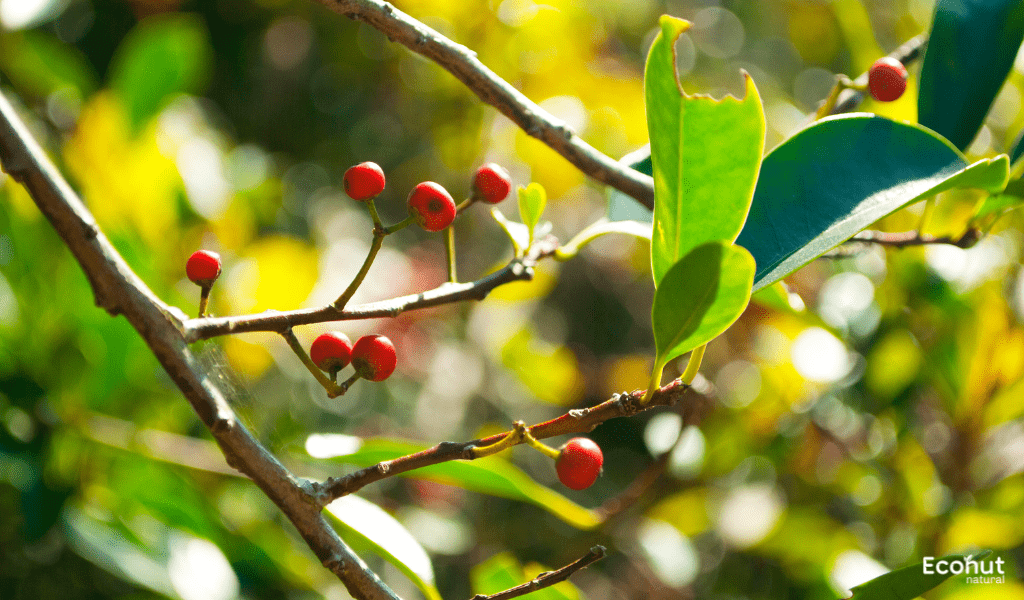The medium-sized Kupilu tree (Strychnos nux-vomica) has a short, twisted trunk. The tree’s wood is white, closely-grained, extremely resilient, and firm. Young tree shoots are dark green in color, and the plant has erratic branches coated in smooth, ash-grey bark.
Nux vomica is also known by the names quaker buttons, vishamushti, deadly nut, nux vomica, nux vomique, and strychnous semen. An extensively recognized toxic plant in Indian ayurvedic medicine is kapilu. In Ayurveda, it is discussed under upvisha gana.
Description
This herb’s seeds have aphrodisiac, appetizer, digestive, purgative, and stimulating properties. Following cleansing, it is used to create a variety of formulations in Ayurveda. The principal chemicals found in this plant are.
Botanical Name:
Strychnos nux-vomica
Family:
Loganiaceae
Leaves:
The leaves are either deciduous or evergreen. They have a glossy covering and are placed in opposition to one another on the stem in a deep green color. They are oval-shaped, short-stalked, smooth-surfaced on both sides, and between 4 and 10 centimeters long and 3 and 7.6 cm wide.
Flowers:
Clusters of tiny, fragrant, white or greenish-white blooms grow at the terminal ends of branches. With five lobes and a cylindrical corolla tube, they have a salverform form.
Fruit:
The berry’s spherical, fleshy form changes from green to an orange-red color. The most poisonous portion of the plant is its 1-3 spherical, flattened seeds, which are enclosed in a thick, leathery shell.
Seeds:
Nux vomica as the seeds are also called, are flat, disc-shaped, and have a diameter of one to two centimeters. They are grayish-brown in appearance with a paler hilum, and they taste harsh.
Habitat:
Kupilu is indigenous to Australia and South East Asia’s tropical and subtropical zones. It is found in India in the wet deciduous and semi-evergreen forests of Maharashtra, which are widely dispersed throughout the 400-meter-high Konkani and Shayadri foothills of the Western Ghats.
Parts Used:
- Leaves
- Bark
- Roots
- Fruits
- Seeds
Dosage:
- 60-125mg dose of purified seeds is recommended.
- Oil – 3-5 drops
- Seeds- 30-50mg
Chemical Constituents
The methanolic extracts of raw and purified seeds contained alkaloids, tannins, carbohydrates, proteins, and fixed oils, according to the preliminary phytochemical analysis. It was discovered that the purified seeds lacked the glycoside loganin, which was present in the raw seeds.
Other Language Names of Kupilu (Strychnos nux-vomica)
Arabian name – Ajaraki, Habbul gurav
Parse name – Kuchula, Phuloosemaahi
Hindi name – Kuchla
Marathi name – Kajara
Gujarati name – Jherkuchla, Zerkochala
Tamil name – Yettikottai
English name – Nux vomica
Telugu name – Mushini ginjalu, Mushti vittulu
Bengali name – Kunchila
Malayalam name – Kajjeel
Scientific Classification
| Kingdom | Plantae |
| Order | Gentianales |
| Family | Loganinaceae |
Ayurvedic Properties
Hindi/Sanskrit
- Rasa -Katu,Tikta,Katu
- Guna -Laghu
- Virya -Ushna
- Vipaka -Katu
English
- Taste -Pungent, Bitter
- Physical Property-Light
- Potency- Hot
- Metabolic Property (After Digestion)-Pungent
Kupilu (Strychnos nux-vomica) Uses
- Nux vomica leaf poultices are used to treat chronic ulcers and wounds to promote faster healing; leaf decoctions are particularly helpful for paralytic problems. Fruit pulp administered topically to treat paralysis.
- In addition to being a great appetizer, seeds can also be used to stimulate the digestive fire, alleviate colic in the abdomen, treat piles, and treat other abdominal ailments.
- Additionally, it is used to treat a variety of mental illnesses, including epilepsy, delirium, convulsions, anxiety, nerve debility, and hysteria.
- This plant is used to treat impotence, spermatorrhoea, general tiredness, erectile dysfunction, and sexual debility in men.
- These days, diabetes is a big concern. This herb is used to decrease blood sugar levels that are too high.
Don’t miss: Khurasani Ajwain, Black Henbane (Hyoscyamus Niger) Ayurvedic Properties, Benefits, Dosage & Side Effects
Kupilu (Strychnos nux-vomica) Benefits
Cancer:
Numerous early investigations on the cellular structure of the human body have revealed that nux vomica may inhibit the growth of cancerous cells by promoting apoptosis, a form of programmed cell death.
Improves Immunity:
Kuchla has a major role in boosting the body’s general vitality and endurance. These plants’ medicinal ingredients prolong the lifetimes of several organs while also relieving weakness and fatigue. Additionally, it enhances the adrenal glands’ ability to operate, which lowers stress levels.
Motion Sickness:
According to the National Center for Homeopathy, if you suffer from extreme nausea and vomiting along with severe headaches in the back of your head or eyes, nux vomica may be used in combination with other medications to cure motion sickness. You get nauseated by the scents of coffee and tobacco and lose your appetite.
Remedies Headaches:
Kuchla works wonders for tension headaches, chronic headaches, and other issues. The common causes of headaches are stress, worry, a demanding workload, and so forth. It improves nerve function, relaxes the brain, and calms inflamed nerves.
Constipation:
In homeopathic treatment, nux vomica( Strychnos nux-vomica) is frequently advised for constipation issues. Nux vomica is used, according to the National Center for Homeopathy, to break a laxative habit in cases where the patient has trouble passing stool without resorting to a laxative. On some days, it is usually advised to take one dose every day right before bed.
Kupilu (Strychnos nux-vomica) Side Effects
- Liver failure
- Death
- Restlessness
- Anxiety
- Muscle spasms
- Convulsions
- Seizures
- Breathing problems
- Dizziness
- Neck and back stiffness
Conclusion
Kupilu has a long history of use in traditional medicine, and because of its strong poisonous qualities, it tells an interesting but important story. Kuchla is used to treat sexual difficulties, improve heart health, improve digestion, and many more uses when it is thoroughly cleansed. Although it has historically been used for a variety of medical purposes, its toxicity necessitates supervision and careful management.
FAQS
What is the purpose of Strychnos nux-vomica?
Medicine is made from the seed. Nux vomica includes two poisonous substances: brucine and strychnine. Nux vomica is used to treat a variety of ailments, including migraines, erectile dysfunction (ED), stomach edema, constipation, anxiety, and anxiety. However, these claims are not well supported by scientific research.
What is the Ayurvedic use of nux vomica?
For ages, nux vomica has been a component of conventional medical practices. It is referred to as “kuchla” in Ayurveda and is used to cure a variety of ailments, such as digestive problems, hunger disorders, and neurological illnesses.
What is the common name of Kupilu?
Kupeelu, also known as nux vomica (Strychnos nux-vomica Linn.), is a toxic herb that is widely utilized in many ayurvedic preparations and has significant therapeutic value.

